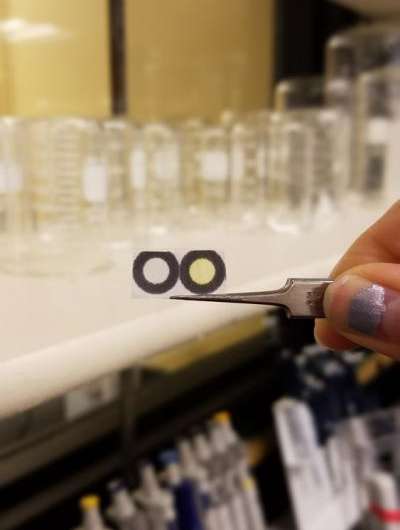How chemists are helping us not get food poisoning

Food poisoning: Many of us have had it, and we won't soon forget it. Colorado State University chemists are trying to make it so we can.
Borrowing concepts from medical diagnostic devices, they've created a simple, cheap set of handheld tests that can detect the presence of many water or food-borne pathogens. If applied in the field, such tests could greatly reduce the number of expensive follow-up tests needed to keep the food supply safe from fecal contamination.
The new testing systems are innovations from the lab of Chuck Henry, professor and chair of the Department of Chemistry. The research is in Analytical Chemistry, a publication of the American Chemical Society (ACS), and is the subject of an ACS news release. The paper includes authorship by graduate students Jaclyn Adkins and Katherine Boehle, CSU research assistant Colin Friend, undergraduate researcher Briana Chamberlain, and Bledar Bisha of the University of Wyoming.
For their study, Henry and colleagues targeted a broad class of bacteria known as fecal indicator bacteria (FIB), which cause the highest number of hospitalizations and deaths from food poisoning. A common culprit: the use of unsafe water to irrigate green vegetables like alfalfa sprouts, spinach and lettuce.
While federal regulations require regular testing of fruits and vegetables for contamination with fecal matter, standard processes could use improvement. Common techniques like immunoassays and polymerase chain reactions (PCR) work reasonably well, but they can lead to false positives and require expensive equipment. The gold standard for bacterial detection is a lab culture, but this can take up to 48 hours to complete.
Henry and colleagues went for accurate, simple and cheap. They made two types of tests that detect an enzyme associated with the FIB bacteria. The first is a small strip of paper treated with a substrate molecule that changes color when it contacts the bacterial enzyme - similar to a home pregnancy test. The researchers envision a smart phone app could be coupled with the paper test.
"We found that with filter paper, wax and a little bit pf packing tape, we can do quite a bit of chemistry on here," Henry said. "That's about 2 cents worth of materials."
Their second test is electrochemical and consists of screen-printed carbon electrodes on transparent sheets, which indicate the same bacteria by being inserted into a reader. The setup is similar to a home glucometer.
The researchers ran tests of contaminated water from a nearby lagoon, as well as water contaminated with E. coli and Enterococcus faecalis that was used to wash clean alfalfa sprouts. Both tests detected the harmful bacteria within four to 12 hours.
They next want to build a mobile computing platform for their tests. They're working on a Raspberry Pi-based system that could perform kinetic measurements to detect changes in the bacteria levels over time, and automatically transmit the information to a cloud platform. The team is working with computer science researcher Sangmi Pallickara on these advances.
Henry explained that his lab's new tests can't tell exactly which bacteria are present, but they can detect the broad class of FIB bacteria that are usually responsible for foodborne illness outbreaks or closed beaches during the summer. "At this point, it is accurate but not specific," Henry said. "This is the test that tells you that you need to do more tests."
In contrast, PCR tests for bacteria, which are currently used for food safety, are more specific, but slower and more expensive. A cheap, simple pre-test like Henry et al.'s could save money and time by cutting back on the overall number of food safety tests needed.
The research has been supported in part by the Catalyst for Innovative Partnerships (CIP), a program of the CSU Office of the Vice President for Research that funds cross-disciplinary science. Through CIP, Henry has collaborated with researchers in the Department of Microbiology, Immunology and Pathology. As a result, the food safety project has included the perspective and expertise of microbiologists, who would be most likely to use the devices in the field.
The CIP team, which includes researchers Brian Geiss and Elizabeth Ryan, is also studying antimicrobial resistance, among other projects.
More information: Jaclyn A. Adkins et al, Colorimetric and Electrochemical Bacteria Detection Using Printed Paper- and Transparency-Based Analytic Devices, Analytical Chemistry (2017). DOI: 10.1021/acs.analchem.6b05009
Journal information: Analytical Chemistry
Provided by Colorado State University




















